NCERT Exemplar Solutions Class 9 Science Chapter 5 – Free PDF Download
The NCERT Exemplar Solution for Class 9 Science Chapter 5 The Fundamental Unit of Life is an influential study material for students studying CBSE Class 9. This chapter has basic concepts that are required to understand advanced Biology-related concepts. Students who are planning to take Biology in their higher secondary classes should refer to the NCERT Exemplar. This solution presents answers to the questions provided with NCERT Exemplar questions, like fundamental unit of life MCQs with answers, short and long answer questions. This page has 29 multiple-choice questions, 23 short answer questions and 7 long answer questions.
This chapter is about cells, which are the fundamental unit of life. Every organism living on this planet is made of a cell, which is often called the building block of life. After reading the whole chapter, students are advised to solve the higher-order thinking questions from the NCERT Exemplar Science Class 9 Chapter 5 The Fundamental Unit of Life. Visit the below link to get the free PDF of the NCERT Exemplar for Class 9 Chapter 5.
Download the PDF of NCERT Exemplar for Class 9 Science Chapter 5 – The Fundamental Unit of Life
Access Answers of the NCERT Exemplar for Class 9 Science Chapter 5 – The Fundamental Unit of Life
Multiple Choice Questions
1. Which of the following can be made into crystal?
(a) A Bacterium
(b) An Amoeba
(c) A Virus
(d) A Sperm
Soln
Answer is (c) A Virus
Explanation:
Viruses are considered as the intermediates between living and non- living as they cannot metabolize or reproduce on their own For all its processes virus requires a host. Viruses can be stored as crystal like chemicals. Virus crystals are a collection of millions of virus cells.
2. A cell will swell up if
(a) The concentration of water molecules in the cell is higher than the concentration of water molecules in surrounding medium
(b) The concentration of water molecules in surrounding medium is higher than water molecules concentration in the cell
(c) The concentration of water molecules is same in the cell and in the surrounding medium
(d) Concentration of water molecules does not matter
Soln:
Answer is (b) The concentration of water molecules in surrounding medium is higher than water molecules concentration in the cell.
Explanation:
When the concentration of water molecules in surrounding medium is higher than water molecules concentration in the cell, water from the surroundings enters the cell through osmosis and the cell swells up.
3. Chromosomes are made up of
(a) DNA
(b) protein
(c) DNA and protein
(d) RNA
Soln:
Answer is (c) DNA and protein
4. Which of these options are not a function of Ribosomes?
(i) It helps in manufacture of protein molecules
(ii) It helps in manufacture of enzymes
(iii) It helps in manufacture of hormones
(iv) It helps in manufacture of starch molecules
(a) (i) and (ii)
(b) (ii) and (iii)
(c) (iii) and (iv)
(d) (iv) and (i)
Soln:
Answer is (c) (iii) and (iv)
Explanation:
Proteins are produced in ribosomes hence they are called protein factories. Enzymes are proteins. Hormones and starch are not produced in ribosome hence option iii) and iv) are wrong statements.
5. Which of these is not related to endoplasmic reticulum?
(a) It behaves as a transport channel for proteins between nucleus and cytoplasm
(b) It transports materials between various regions in cytoplasm
(c) It can be the site of energy generation
(d) It can be the site for some biochemical activities of the cell
Soln:
Answer is (c) It can be the site of energy generation
Explanation:
Energy is produced in the mitochondria hence option c is not related to Endoplasmic reticulum.
6. Following are a few definitions of osmosis. Read carefully and select the correct definition
(a) Movement of water molecules from a region of higher concentration to a region of lower concentration through a semipermeable membrane
(b) Movement of solvent molecules from its higher concentration to lower concentration
(c) Movement of solvent molecules from higher concentration to lower concentration of solution through a permeable membrane
(d) Movement of solute molecules from lower concentration to a higher concentration of solution through a semipermeable membrane
Soln:
Answer is (a) Movement of water molecules from a region of higher concentration to a region of lower concentration through a semipermeable membrane.
Explanation:
Osmosis is a special type of diffusion in which water molecules move from a region of higher concentration to a region of lower concentration through a semipermeable membrane. Option b) Movement of solvent molecules from its higher concentration to lower concentration is called diffusion.
7. Plasmolysis in a plant cell is defined as
(a) break down (lysis ) of plasma membrane in hypotonic medium
(b) shrinkage of cytoplasm in hypertonic medium
(c) shrinkage of nucleoplasm
(d) none of them
Soln:
Answer is (b) shrinkage of cytoplasm in hypertonic medium
Explanation:
Living plant cell loses water through osmosis resulting in shrinkage or contraction of the contents of the cell away from the cell wall. This phenomenon is known as plasmolysis. When plant cell has more water content than in the surrounding plant cell tend to transfer water to its surroundings, which results in shrinkage of the cell through plasmolysis.
8. Which of the following are covered by a single membrane?
(a) Mitochondria
(b) Vacuole
(c) Lysosome
(d) Plastid
Soln:
Answer is (c) Lysosome
Explanation:
Mitochondria, Vacuole and plastids are covered by double-layered membranes hence Lysosome is the answer.
9. Find out the false sentences
(a) Golgi apparatus is involved with the formation of lysosomes
(b) Nucleus, mitochondria and plastid have DNA; hence they are able to make their own structural proteins
(c) Mitochondria is said to be the powerhouse of the cell as ATP is generated in them.
(d) Cytoplasm is called as protoplasm
Soln:
Answer is (d) Cytoplasm is called as protoplasm
Explanation:
Cytoplasm is a part of protoplasm in the cell which surrounds the nucleus. Therefore, cytoplasm is not called protoplasm hence option d is the false sentence
10. Find out the correct sentence
(a) Enzymes packed in lysosomes are made through RER (rough endoplasmic reticulum)
(b) Rough endoplasmic reticulum and smooth endoplasmic reticulum produce lipid and protein respectively
(c) Endoplasmic reticulum is related to the destruction of plasma membrane
(d) Nucleoid is present inside the nucleoplasm of eukaryotic nucleus
Soln:
Answer is (a) Enzymes packed in Lysosomes are made through RER (rough endoplasmic reticulum).
Explanation:
RER has ribosomes present on its surface which are responsible for the synthesis of proteins and enzymes are the proteins. Hence option a) is correct. Rough endoplasmic reticulum has no role in the production of lipid. Similarly, Endoplasmic reticulum has no role in the destruction of the plasma membrane. Nucleoid is an undefined nuclear region in prokaryotes.
11. Which cell organelle plays a crucial role in detoxifying many poisons and drugs in a cell?
(a) Golgi apparatus
(b) Lysosomes
(c) Smooth endoplasmic reticulum
(d) Vacuoles
Soln:
Answer is (c) Smooth endoplasmic reticulum
Explanation:
SER plays an important role in detoxifying many poisons and drugs in the liver cells of vertebrates.
12. The proteins and lipids, essential for building the cell membrane, are manufactured by
(a) rough endoplasmic reticulum
(b) golgi apparatus
(c) plasma membrane
(d) mitochondria
Soln:
Answer is (a) rough endoplasmic reticulum
Explanation:
Endoplasmic reticulum plays an important role in the production of both lipids and proteins. SER produces lipids and RER produces proteins.
13. The undefined nuclear region of prokaryotes are also known as
(a) nucleus
(b) nucleolus
(c) nucleic acid
(d) nucleoid
Soln:
Answer is (d) nucleoid
14. The cell organelle involved in forming complex sugars from simple sugars are
(a) endoplasmic reticulum
(b) ribosomes
(c) plastids
(d) golgi apparatus
Soln:
Answer is (d) golgi apparatus
Explanation:
Golgi apparatus is involved in the packaging and transport of many biomolecules such as proteins, lipids and carbohydrates.
15. Which out of the following is not a function of vacuole?
(a) Storage
(b) Providing turgidity and rigidity to the cell
(c) Waste excretion
(d) Locomotion
Soln:
Answer is (d) Locomotion
Explanation:
Vacuoles are responsible for storage, turgidity and rigidity of the cell and waste excretion. Locomotion is carried out by specialised organelles present outside cytoplasm. Vacuoles are present inside the cytoplasm hence option d) is a wrong statement.
16. Amoeba acquires its food through a process, termed
(a) exocytosis
(b) endocytosis
(c) plasmolysis
(d) exocytosis and endocytosis both
Soln:
Answer is (b) endocytosis
Explanation:
Endocytosis is taking in of matter by a living cell by invagination of its membrane to form a vacuole. In endocytosis, substances that are external to a cell are brought into the cell. Membrane-bound vesicles containing cellular molecules are transported to the cell membrane in exocytosis. Process of contraction of the protoplast of a plant cell as a result in the loss of water from the cell is called plasmolysis.
17. Cell wall of which one of these is not made up of cellulose?
(a) Bacteria
(b) Hydrilla
(c) Mango tree
(d) Cactus
Soln:
Answer is (a) Bacteria
Explanation:
Hydrilla, Mango tree and cactus are plants hence their cell wall is made up of cellulose. The cell wall of Bacteria is made of polysaccharide called Peptidoglycan.
18. Silver nitrate solution is used to study
(a) endoplasmic reticulum
(b) golgi apparatus
(c) nucleus
(d) mitochondria
Soln:
Answer is (b) golgi apparatus
19. Organelle other than nucleus, containing DNA is
(a) endoplasmic reticulum
(b) golgi apparatus
(c) mitochondria
(d) lysosome
Soln:
Answer is (c) mitochondria
Explanation:
Mitochondria and Chloroplast are the organelles that have separate DNA called mitochondrial DNA and chloroplast DNA.
20. Kitchen of the cell is
(a) mitochondria
(b) endoplasmic reticulum
(c) chloroplast
(d) golgi apparatus
Soln:
Answer is (c) chloroplast
Explanation:
Food in plants is produced inside Chloroplast hence Chloroplast is known as kitchen of the cell.
21. Lipid molecules in the cell are synthesized by
(a) smooth endoplasmic reticulum
(b) rough endoplasmic reticulum
(c) golgi apparatus
(d) plastids
Soln:
Lipid molecules in the cell are synthesized by smooth endoplasmic reticulum
22. Cell arise from the pre-existing cells was stated by
(a) Haeckel
(b) Virchow
(c) Hooke
(d) Schleiden
Soln:
Answer is (b) Virchow
23. Cell theory was given by
(a) Schleiden and Schwann
(b) Virchow
(c) Hooke
(d) Haeckel
Soln:
Answer is (a) Schleiden and Schwann
Explanation:
Schleiden and Schwann were the first to propose the cell theory which stated that all plants and animals are made up of cell and cell is the basic unit of life.
24. The only cell organelle seen in a prokaryotic cell is
(a) mitochondria
(b) ribosomes
(c) plastids
(d) lysosomes
Soln:
Answer is (b) ribosomes
25 . Organelle without a cell membrane is
(a) ribosome
(b) golgi apparatus
(c) chloroplast
(d) nucleus
Soln:
Answer is (a) ribosome
Explanation:
Golgi bodies, Chloroplast and nucleus are membrane-bound organelles and ribosomes are organelles without membrane.
26. 1 µm is
(a) 10–6 m
(b) 10–9 m
(c) 10–10 m
(d) 10–3 m
Soln:
Answer is (a) 10–6 m
Explanation:
10–3 m- millimetre 10–6 m – Micrometer 10–9 m – nanometer
27. Lysosome arises from
(a) endoplasmic reticulum
(b) golgi apparatus
(c) nucleus
(d) mitochondria
Soln:
Answer is (b) golgi apparatus
Explanation:
Main function of golgi apparatus is secretion, packaging and modification of proteins. It is also involved in the synthesis of new membranes and lysosomes.
28. Living cells were discovered by
(a) Robert Hooke
(b) Purkinje
(c) Leeuwenhoek
(d) Robert Brown
Soln:
Answer is (c) Leeuwenhoek
Explanation:
Robert hook first observed cells but he observed dead cork cell and it was Leeuwenhoek who observed living cell from his microscope.
29. Select the odd one out
(a) The movement of water across a semi-permeable membrane is affected by the amount of substances dissolved in it.
(b) Membranes are made of organic molecules like proteins and lipids
(c) Molecules soluble in organic solvents can easily pass through the membrane.
(d) Plasma membranes contain chitin sugar in plants
Soln:
Answer is (d) Plasma membranes contain chitin sugar in plants
Explanation:
Plasma membrane contains sugar is a wrong statement and rest other statements are true. The plant plasma membrane contains cellulose in it.
Short Answer Questions
30. Why are lysosomes known as ‘suicide-bags’ of a cell?
Soln:
Lysosomes are the organelles that have digestive enzymes. When lysosomes burst, the digestive enzymes released start digesting its own cells. That is why they are known as suicidal bags.
31. Do you agree that “A cell is a building unit of an organism”? If yes, explain why?
Soln:
Yes, cells are the building unit of an organism. Cells performing similar functions join together to form tissues, which further forms organs and organ systems. This forms an organism. In a unicellular organism, a single cell performs all the life processes.
32. Why does the skin of your finger shrink when you wash clothes for a long time?
Soln:
Soap solution is hypertonic in nature which makes the water move out of the cells in your hand which results in shrinkage of fingers when you wash clothes for a long time.
33. Why is endocytosis found in animals only?
Soln:
Endocytosis is found only in animals because the cell wall is absent in animals. Due to this, the movement of substances inside the cell is easier in animals than in plants.
34. A person takes concentrated solution of salt, after sometime, he starts vomiting. What is the phenomenon responsible for such situation? Explain.
Soln:
Upon consuming salt solution Osmosis process takes place which results in dehydration. This is the reason for vomiting of the person who consumes salt solution.
35. Name any cell organelle which is non-membranous.
Soln:
The ribosome is the only non-membranous cell organelle.
36. We eat food composed of all the nutrients like carbohydrates, proteins, fats, vitamins, minerals and water. After digestion, these are absorbed in the form of glucose, amino acids, fatty acids, glycerol etc. What mechanisms are involved in the absorption of digested food and water?
Soln:
Absorption and digestion involve diffusion and osmosis, respectively.
37. If you are provided with some vegetables to cook, you generally add salt to the vegetables during the cooking process. After adding salt, vegetables release water. What mechanism is responsible for this?
Soln:
After adding salt, vegetables release water due to the process of osmosis. The addition of salt makes the external environment hypertonic. This means that the concentration of water outside is lowered as compared to the concentration of water inside the cell. This results in the elimination of water from the vegetables due to exosmosis.
38. If cells of onion peel and RBC are separately kept in hypotonic solution, what among the following will take place? Explain the reason for your answer.
(a) Both the cells will swell.
(b) RBC will burst easily while cells of onion peel will resist the bursting to some extent.
(c) a and b both are correct.
(d) RBC and onion peel cells will behave similarly.
Soln:
(c) a and b both are correct.
Explanation:
When the surrounding medium is hypotonic water moves inside the cell. This leads to the swelling of cells. RBCs do not have a plasma membrane and they swell and burst easily. Plant cells have a cell wall which will prevent them from bursting.
39. Bacteria do not have chloroplast but some bacteria are photoautotrophic in nature and perform photosynthesis. Which part of the bacterial cell performs this?
Soln:
Small vesicles associated with plasma membrane are present in bacteria. These vesicles have pigment which can trap sunlight to carry photosynthesis.
40. Match the following A and B
(A) – (B)
(a) Smooth endoplasmic reticulum – (i) Amoeba (b) Lysosome – (ii) Nucleus (c) Nucleoid – (iii) Bacteria (d) Food vacuoles – (iv) Detoxification (e) Chromatin material – (v) Suicidal bag and nucleolus
Soln:
(A) – (B) (a) Smooth endoplasmic reticulum – (iv) Detoxification (b) Lysosome – (v) Suicidal bag and nucleolus (c) Nucleoid – (iii) Bacteria (d) Food vacuoles -(i) Amoeba (e) Chromatin material – (ii) Nucleus
41. Write the name of different plant parts in which chromoplast, chloroplast and leucoplast are present.
Soln:
Chromoplast is present in Flower and fruit Chloroplast is found in the leaves Leucoplast is present in the roots
42. Name the organelles which show the analogy written as under
(a) Transporting channels of the cell——
(b) Power house of the cell——
(c) Packaging and dispatching unit of the cell——
(d) Digestive bag of the cell——
(e) Storage sacs of the cell——
(f) Kitchen of the cell——
(g) Control room of the cell——
Soln:
Answers: a. Endoplasmic reticulum b. Mitochondria c. Golgi apparatus d. Lysosomes e. Vacuoles f. Chloroplast g. Nucleus
43. How is a bacterial cell different from an onion peel cell?
Soln:
|
Bacterial Cell |
Onion Peel |
| Prokaryotic cell |
Eukaryotic cell |
|
Lack of an organized nucleus, the genetic material present in the form of the nucleoid. |
Well-organised Nucleus |
|
Nuclear membrane absent |
Nuclear membrane present |
| Only a single chromosome is present |
More than one chromosome are present |
|
Membrane-bound organelles absent. |
Membrane-bound organelles present. |
| Nucleolus is absent |
Nucleolus is present. |
|
Cell division takes place by fission or budding. |
Cell division takes place by mitosis or meiosis |
44. How do substances like carbon dioxide (CO2) and water (H2O) move in and out of the cell?
Soln:
Substances like carbon dioxide (CO2) move in and out of the cell by diffusion, and water (H2O) move in and out of the cell through osmosis.
45. How does amoeba obtain its food?
Soln:
Amoeba obtains its food through endocytosis. It has finger-like projections that fuse with the food particle forming a food vacuole. The complex food particles are broken down into simpler ones inside the vacuole which are then diffused into the cytoplasm.
46. Name the two organelles in a plant cell that contain their own genetic material and ribosomes.
Soln:
Chloroplast and mitochondria are the two organelles in a plant cell that contain their own genetic material and ribosomes.
47. Why are lysosomes also known as “scavengers of the cells”?
Soln:
Lysosomes also are known as “scavengers of the cells” because lysosomes have lytic enzymes which are used to destroy pathogens and worn-out cells. Lysosomes also destroy waste materials which are harmful to the cell.
48. Which cell organelle controls most of the activities of the cell?
Soln:
Nucleus controls most of the activities of the cell.
49. Which kind of plastid is more common in
(a) roots of the plant
(b) leaves of the plant
(c) flowers and fruits
Soln:
Answers
a) Leucoplasts are more common in roots of the plant
b) Chloroplasts are more common in leaves of the plant
c) Chromoplasts are more common in flowers and fruits
50. Why do plant cells possess large-sized vacuole?
Soln:
Cells possess large-sized vacuole because vacuoles not only store important material but also contain a sap that gives turgidity to the cell.
51. How are chromatin, chromatid and chromosomes related to each other?
Soln:
Chromatin is the thread-like structure which forms the chromosomes. A copy of duplicated chromosome which is generally joined to the other copy by a centromere is called Chromatid.
Chromosomes: When a cell starts to divide, the tangled mass of chromatin condenses into long threads and finally, rod-like bodies called chromosomes.
52. What are the consequences of the following conditions?
(a) A cell containing higher water concentration than the surrounding medium
(b) A cell having low water concentration than the surrounding medium.
(c) A cell having equal water concentration to its surrounding medium.
Soln:
a) If a cell contains higher water concentration than the surrounding medium then the cell loses water and it shrinks. This process is called exosmosis. b) If a cell has low water concentration than the surrounding medium cell intakes water from the surroundings and the cell bursts. This process is called endosmosis. c) If A cell having equal water concentration to its surrounding medium then there will be no change in the cell.
Long Answer Questions
53. Draw a plant cell and label the parts which
(a) determines the function and development of the cell
(b) packages materials coming from the endoplasmic reticulum
(c) provides resistance to microbes to withstand hypotonic external media without bursting
(d) is site for many biochemical reactions necessary to sustain life.
(e) is a fluid contained inside the nucleus
Soln:

(a) Nucleus: It determines the function and development of the cell (b) Golgi apparatus: It packages materials coming from the endoplasmic reticulum (c) Cell wall: It provides resistance to microbes to withstand hypotonic external media without bursting (d) Cytoplasm: It is a site for many biochemical reactions necessary to sustain life. (e) Nucleoplasm: It is a fluid contained inside the nucleus
54. Illustrate only a plant cell as seen under an electron microscope. How is it different from an animal cell?
Soln:
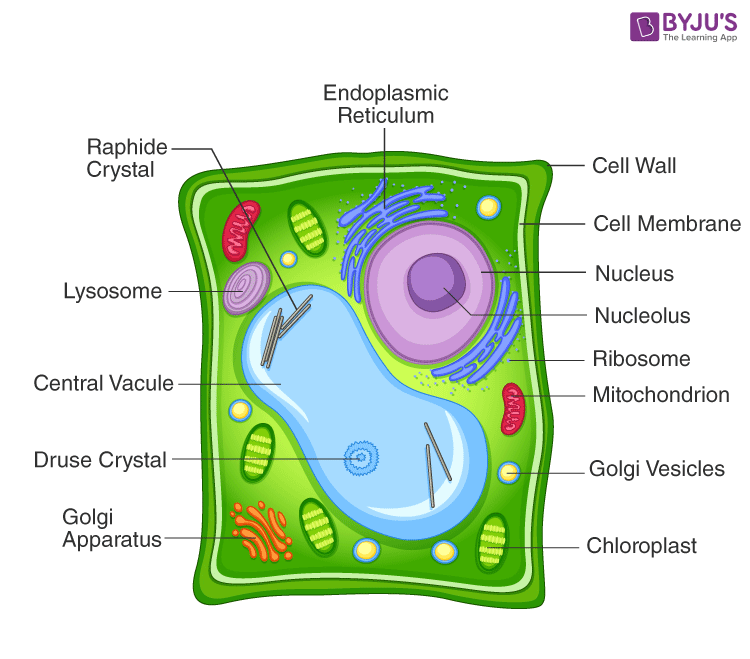 Major differences between a plant cell and animal cell are
Major differences between a plant cell and animal cell are
- Chloroplast in a plant cell but absent in animal cells
- Large central vacuole in plant cell which is absent in animal cells
- The cell wall is present in plant cell and absent in animal cells.
55. Draw a neat labelled diagram of an animal cell.
Soln:
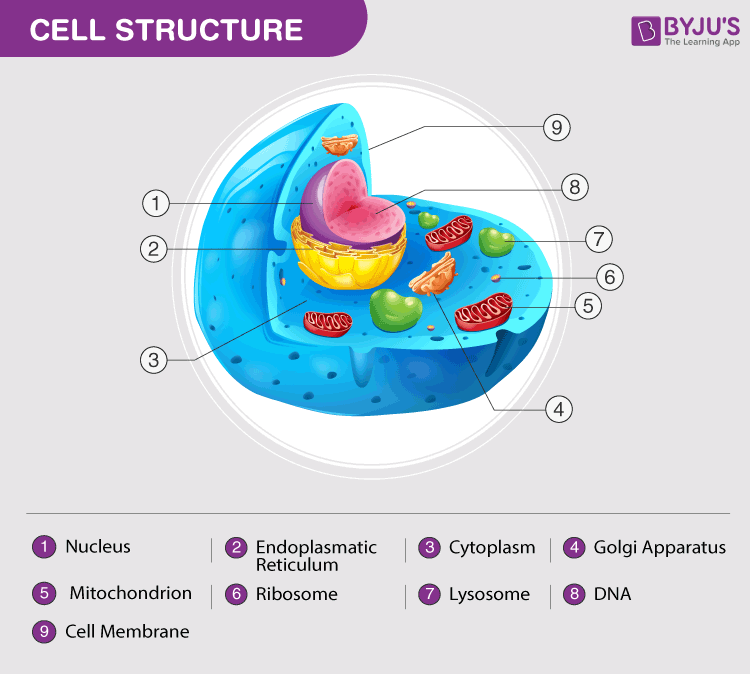
56. Draw a well-labelled diagram of a eukaryotic nucleus. How is it different from nucleoid?
Soln: The difference between the nucleus and nucleoid are given below:
|
Nucleus |
Nucleoid |
| A membrane-bound organelle in the cytoplasm of eukaryotes. |
A particular area in the cytoplasm of eukaryotes. |
|
Contains more than one chromosome. |
Contains a single chromosome. |
| Well-organized structure |
Poorly organized structure |
|
Spherical shaped |
Irregular shaped |
| Nucleolus and nucleoplasm present |
Nucleolus and nucleoplasm absent |

57. Differentiate between rough and smooth endoplasmic reticulum. How is endoplasmic reticulum important for membrane biogenesis?
Soln:
| Rough Endoplasmic reticulum | Smooth Endoplasmic reticulum |
| It possesses ribosomes attached to the membrane. | It does not possess ribosomes attached to its membrane. |
| Involved in protein synthesis | Involved in lipid synthesis |
| Found deep inside the cytoplasm. | Found on the periphery. |
| May develop from the nucleus. | May develop from the rough endoplasmic reticulum. |
58. In brief state what happens when
(a) dry apricots are left for sometime in pure water and later transferred to sugar solution?
(b) a Red Blood Cell is kept in concentrated saline solution?
(c) the Plasma membrane of a cell breaks down?
(d) rheo leaves are boiled in water first and then a drop of sugar syrup is put on it?
(e) golgi apparatus is removed from the cell?
Soln:
a) When we put dried raisins or apricots in plain water and leave them for some time cell gains water and swells. If we put some seeds into a concentrated solution of sugar you will observe it loses water and consequently shrinks. b) When red blood cell is kept in concentrated saline solution. The cell loses water immediately and shrinks. c) When the plasma membrane of a cell breaks down, the cell dies. d) On boiling, cells of Rheo leaves die and if we put sugar solution on it there will not be any intake of water due to lack of osmosis. Here cell undergoes plasmolysis concluding only living cells undergo osmosis. e) This stop the formation of vesicles and transport of proteins and lipids is stopped by the removal of Golgi apparatus.
59. Draw a neat diagram of plant cell and label any three parts which differentiate it from an animal cell.
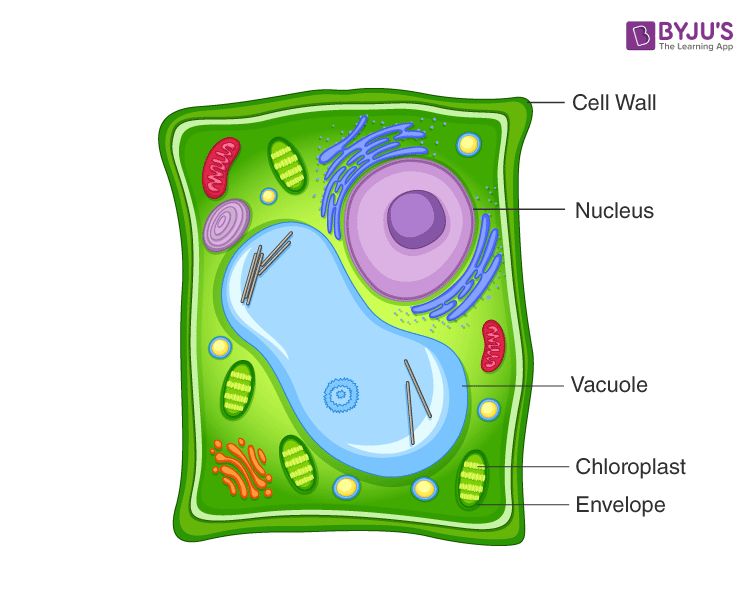
| Also Access |
| NCERT Solutions for Class 9 Science Chapter 5 |
| CBSE Notes for Class 9 Science Chapter 5 |
Concepts Included in the NCERT Exemplar Class 9 Science Chapter 5 The Fundamental Unit of Life
-
- Introduction
- What are living organisms made up of?
- What are these structures?
- What is the cell made up of? What is the structural organisation of a cell?
- Plasma membrane or cell membrane
- Cell wall
- Nucleus
- Cytoplasm
- Endoplasmic reticulum
- Cell organelles
- Golgi apparatus
- Lysosomes
- Mitochondria
- Plastids
- vacuoles
The NCERT Exemplar is provided by BYJU’S to help you understand topics thoroughly. The NCERT Exemplar for Chapter 5 of Class 9 is prepared by our panel of subject experts as per the latest CBSE Syllabus 2023-24 to assist you in understanding the chapter – The Fundamental Unit of Life – in-depth. These solved exemplars help you to score good marks and remember topics for a longer period.
Frequently Asked Questions on NCERT Exemplar Solutions for Class 9 Science Chapter 5
What are the concepts covered in Chapter 5 of NCERT Exemplar Solutions for Class 9 Science?
1. Introduction
2. What are living organisms made up of?
3. What are these structures?
4. What is the cell made up of? What is the structural organisation of a cell?
5. Plasma membrane or cell membrane
6. Cell wall
7. Nucleus
8. Cytoplasm
9. Endoplasmic reticulum
10. Cell organelles
11. Golgi apparatus
12. Lysosomes
13. Mitochondria
14. Plastids
15. Vacuoles
How are viruses alone stored as crystal-covered, according to Chapter 5 of NCERT Exemplar Solutions for Class 9 Science?
Why should I refer to the NCERT Exemplar Solutions for Class 9 Science Chapter 5?
2. Elaborated solutions enable students to understand the concepts efficiently.
3. Step-by-step explanations are provided for the numericals present in this chapter.
4. Simplified and logical language is used in order to boost confidence among students.
5. Pictorial representation is done wherever necessary to help students grasp concepts better.
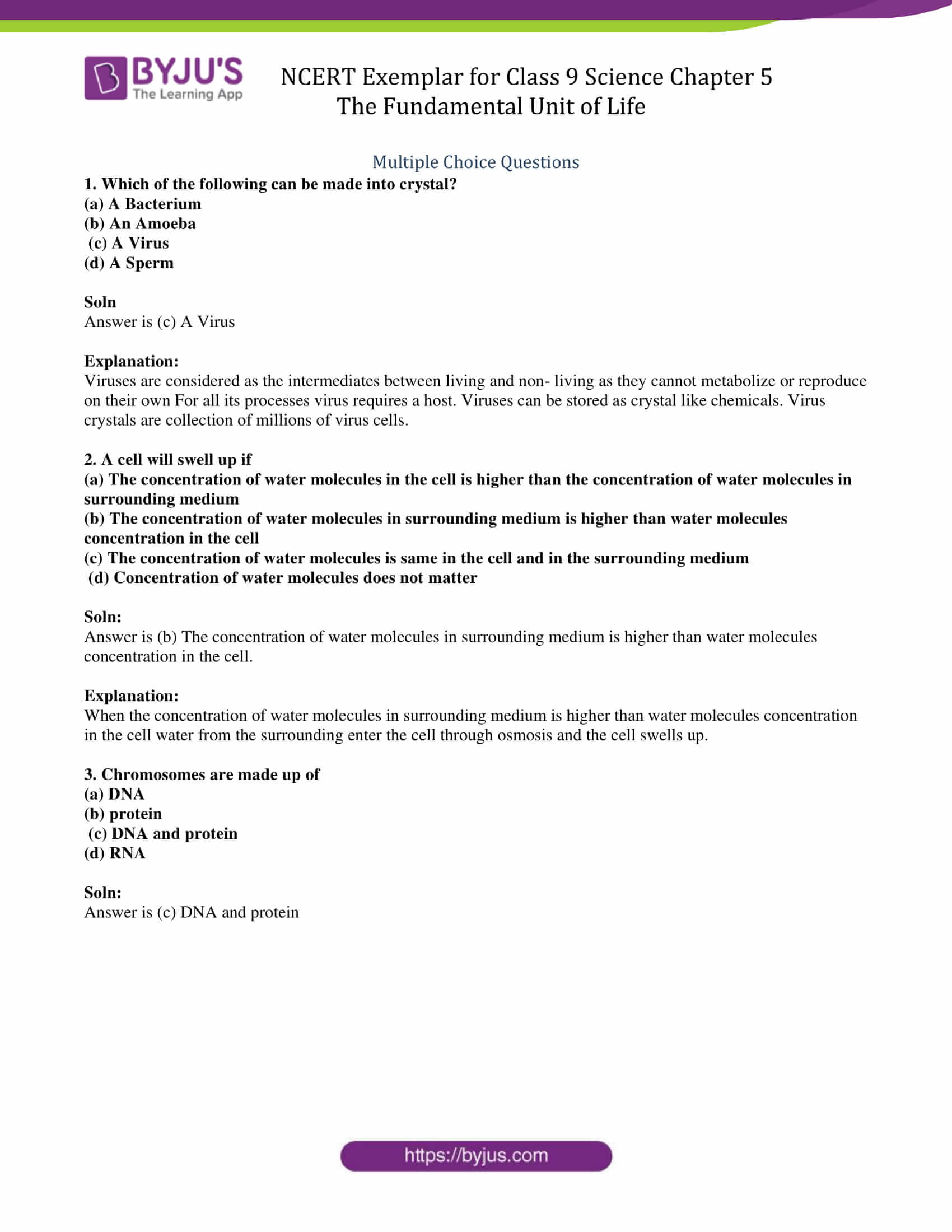










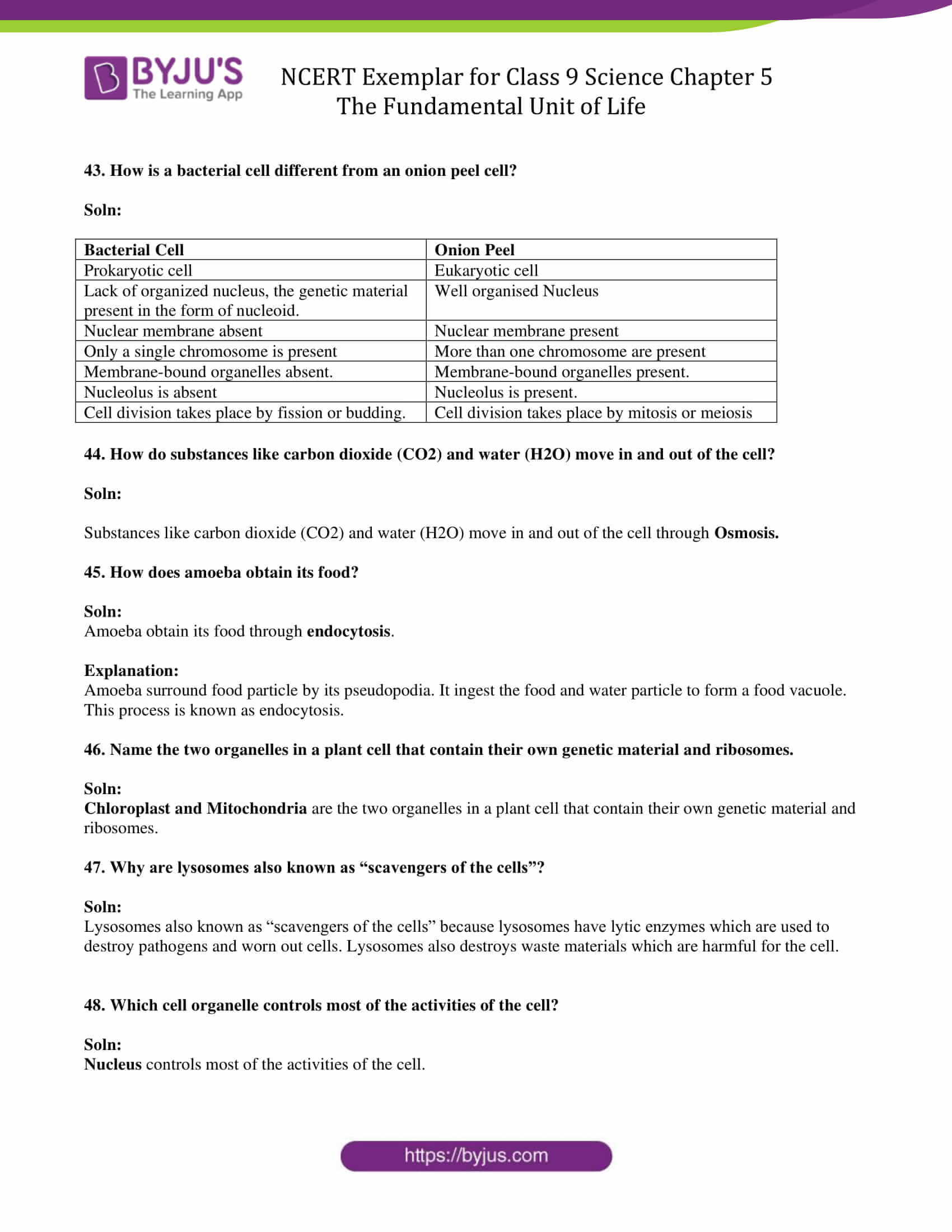


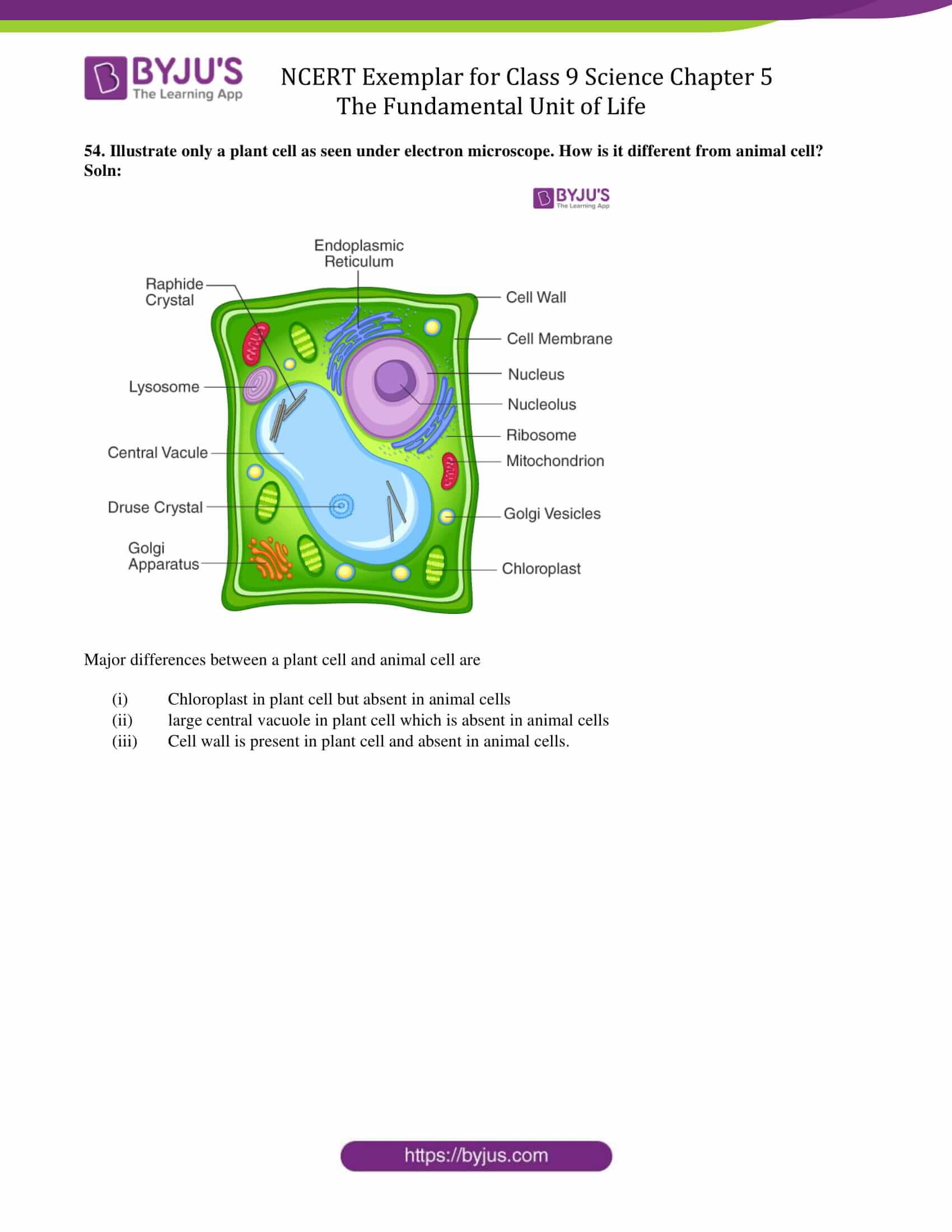
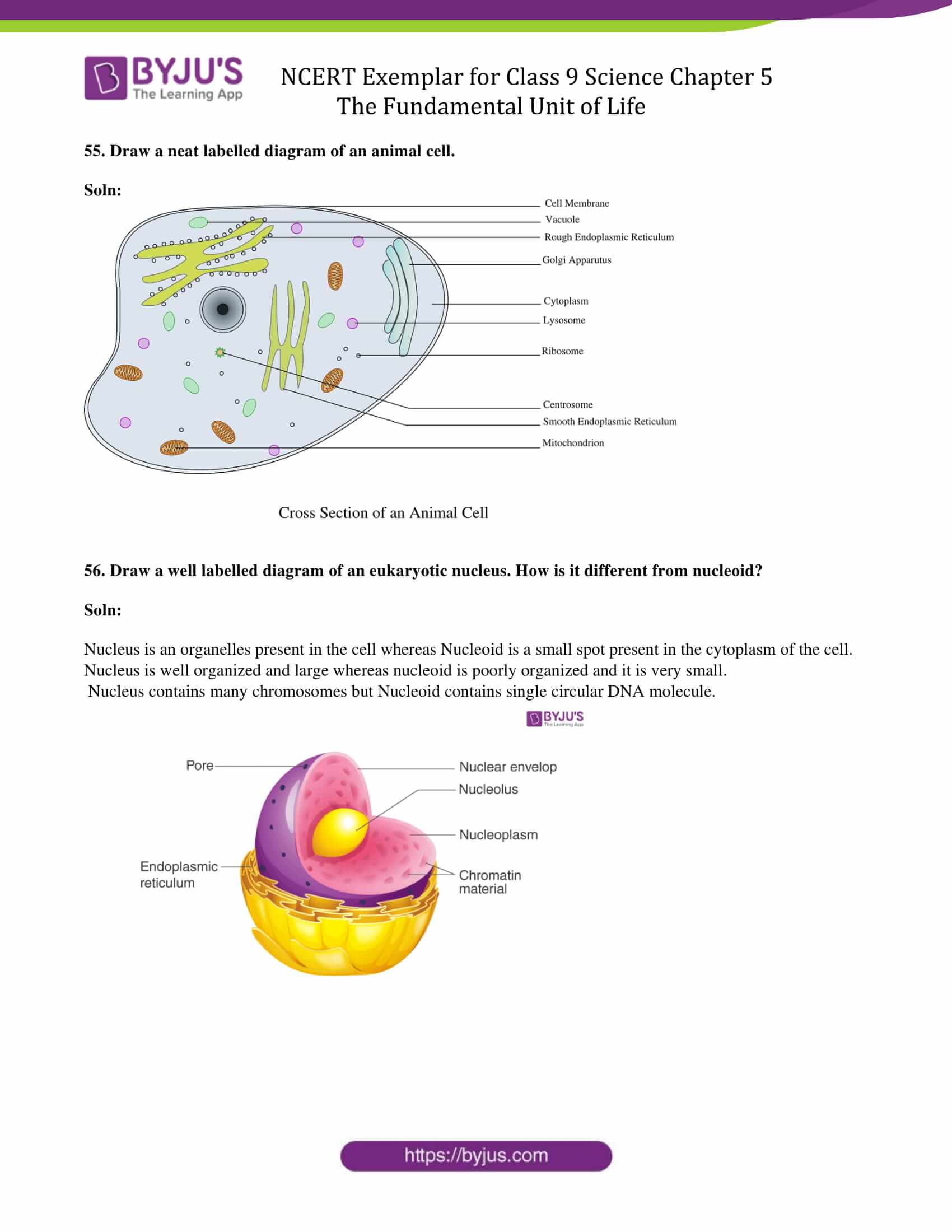

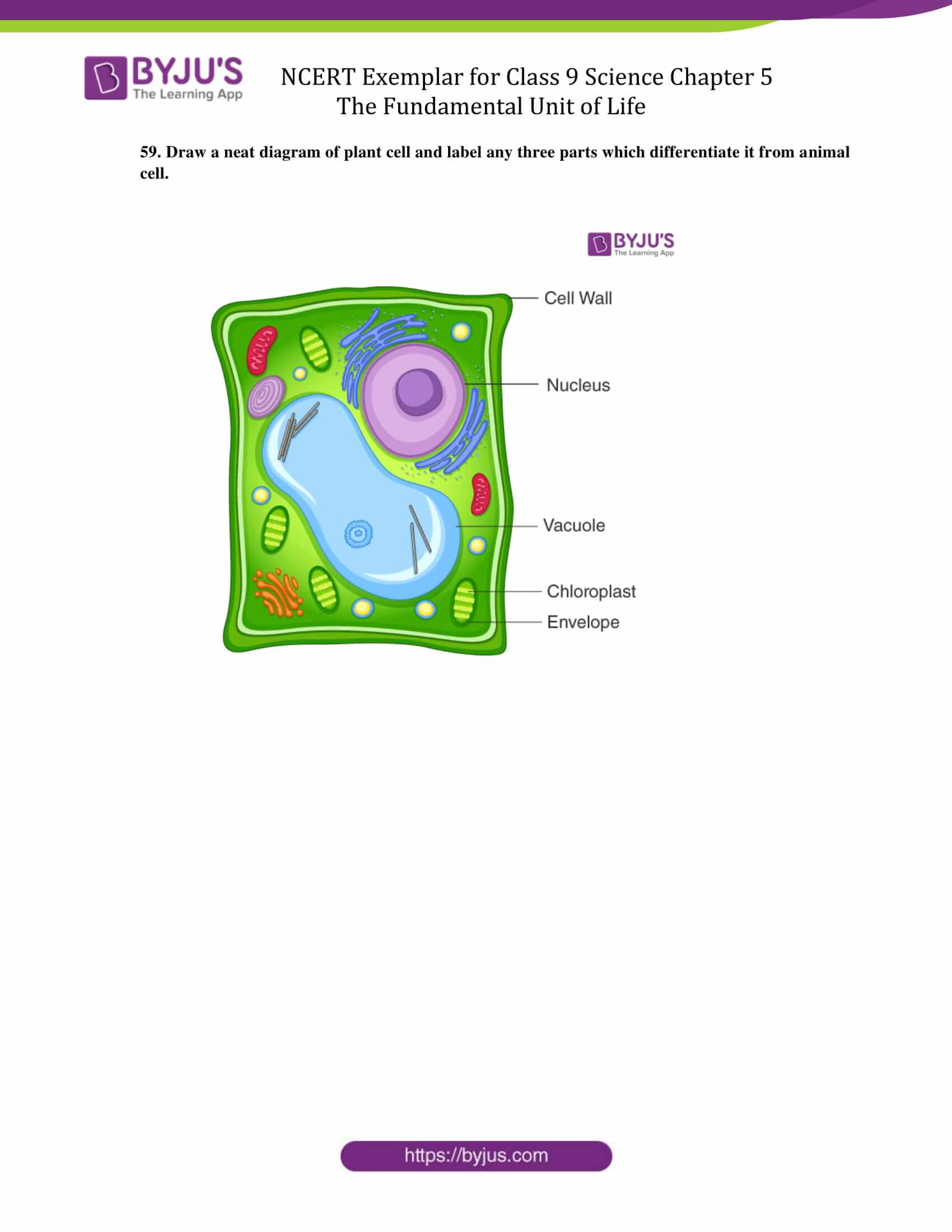
Comments